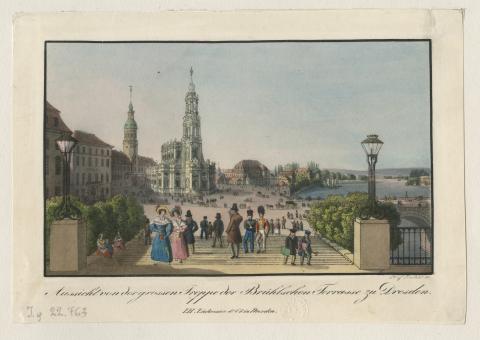Wrocław - Dresden: Heritage and Urban History
-- English version below --
Gdy w 2011 roku Polska i Niemcy zorganizowały pierwszą w dziejach polsko-niemieckich stosunków wystawę na temat tysiąclecia naszego sąsiedztwa, jej niemiecki tytuł brzmiał Tür an Tür – „drzwi w drzwi”. W skali regionalnej tytuł ten doskonale oddaje wzajemną relację dwóch miast: Drezna i Wrocławia, które – położone blisko siebie w sąsiadujących krajach – złączone są podobną historią, kulturą, architekturą.
Zestaw danych Wrocław - Dresden: Urban History and Heritagezawiera grafiki prezentujące historyczny charakter obu miast, ich dziedzictwo oraz proces urbanizacji. Wizerunki dawnych ulic, budynków, mieszkańców oraz panoramy miast umożliwiają nie tylko podróż w czasie, ale także w przestrzeni. Oba miasta były wielokrotnie doświadczane katastrofami i wojnami, które sprawiły, że prezentowana grafika zabytkowa ukazująca dawne Drezno i Wrocław w XV–XIX w. jest nierzadko jedyną pozostałością po historycznych budowlach oraz świadectwem urbanistycznej przeszłości i tradycji kultywowanych w obu miastach.
Przykładem tego jest np. kolorowany wizerunek kościoła św. Krzysztofa we Wrocławiu z 1760 r. będący jednym z niewielu materialnych śladów niezwykle ciekawego zwyczaju świętowania Nowego Roku we Wrocławiu, który polegał na obdarowywaniu się drukowanymi życzeniami noworocznymi napisanymi przez dzwonnika w kościele św. Krzysztofa. Podkolorowana akwaforta z Schlossplatz w Dreźnie z II połowy XIX w. to natomiast historyczny widok centralnej części miasta, która została całkowicie zniszczona podczas bombardowania Drezna w czasie II wojny światowej.
Zestaw danych Wrocław - Dresden: Urban History and Heritagepozwala przenieść się w czasie i przestrzeni miasta pokazując, że za każdym miejscem w urbanistycznej tkance kryje się jakaś historia, którą przywołują właśnie dawne grafiki.
Metadane częściowo pobrano z programu Muza.
When in 2011 Poland and Germany organized the first exhibition in the history of Polish-German relations on the millennium of our neighbourhood, its German title was Tür an Tür - "door to door". On a regional scale, this title perfectly reflects the mutual relationship of two cities: Dresden and Wrocław, situated in two neighbouring countries, relatively close to each other and connected by a similar history, culture and architecture.
The Wrocław - Dresden: Urban History and Heritage dataset contains graphics presenting the historical character of both cities, their heritage and the process of urbanization. The images of old streets, buildings, inhabitants and city panoramas enable not only a journey through time but also through space. Both cities repeatedly experienced catastrophes and wars, which meant that the presented historic graphics showing the former Dresden and Wrocław in the 15th – 19th centuries remind us of formerly existent buildings and are a testimony to the urban past and traditions cultivated in both cities.
One example of such heritage is the coloured image of the church of St. Christopher in Wrocław from 1760, which is one of the few material traces of the extremely interesting (and now extinct) custom of celebrating the New Year in Wrocław, which consisted in giving printed New Year's greetings written by a bell-ringer in the church of St. Christopher. Similarly, the coloured etching of Schlossplatz in Dresden from the second half of the 19th century shows the central part of the city, which was destroyed during the bombing of Dresden during World War II, and the beautiful etchings by Bernardo Bellotto reflect the architecture and street life in Dresden in the mid-18th century.
The Wrocław - Dresden: Urban History and Heritage dataset allows you to move through the time and space of both cities, proving that behind each place in the urban tissue there is a past, recalled by old graphics.
The metadata were partially exported from the Muza program.
